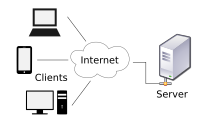
Photo from wikipedia
In recent years, with the rise of the internet of things technology, most devices can be connected to the internet, resulting in fewer and fewer IP addresses. Therefore, the number of applications using… Click to show full abstract
In recent years, with the rise of the internet of things technology, most devices can be connected to the internet, resulting in fewer and fewer IP addresses. Therefore, the number of applications using NAT has also increased. Coupled with the rise of fog computing architecture, NAT traversal has become increasingly difficult to be implemented. Although many methods of traversing firewalls have been proposed and widely used in various communication archiectures, Users cannot rely solely on the central server to establish connections in the peer-to-peer network, which increases the loading on the NAT architecture and transport server. In the past, there have been related papers to solve this problem, and the goal is to increase the success rate of establishing a connection through a NAT server. Therefore, a novel load balancing solution is proposed in this study, and the loading value obtained from the SVM model is adopted as the basis for selecting the network address conversion server. At the end of the study, we not only discuss the maximum server loading, different analysis models, and the delay time added by the new processes in the architecture, but also find the proposed approach is able to achieve the loading balance with only a small increase in delay time.
Journal Title: Journal of Internet Technology
Year Published: 2021
Link to full text (if available)
Share on Social Media: Sign Up to like & get
recommendations!